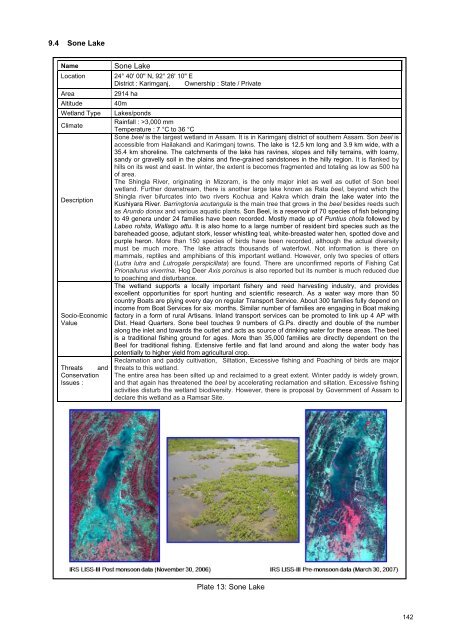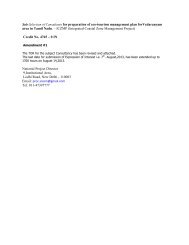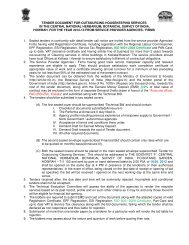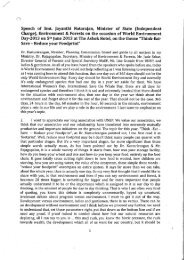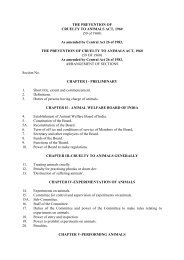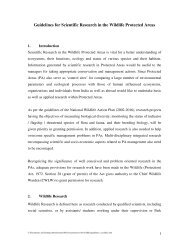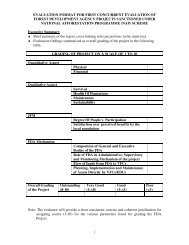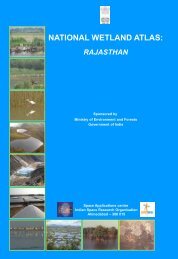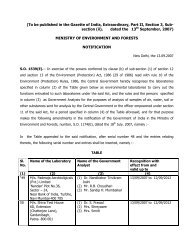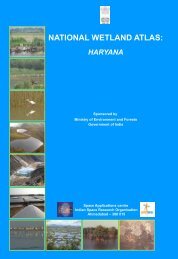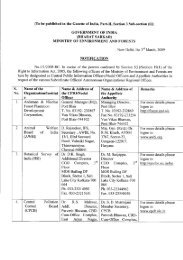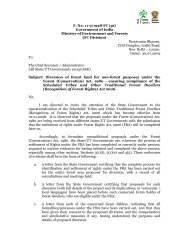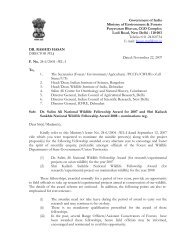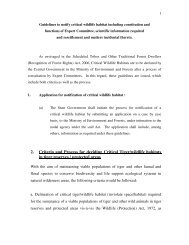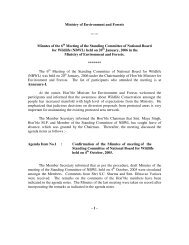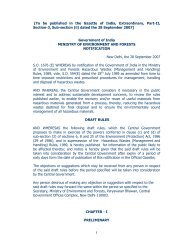Assam - Ministry of Environment and Forests
Assam - Ministry of Environment and Forests
Assam - Ministry of Environment and Forests
Create successful ePaper yourself
Turn your PDF publications into a flip-book with our unique Google optimized e-Paper software.
9.4 Sone LakeNameLocationAreaAltitudeWetl<strong>and</strong> TypeClimateDescriptionSocio-EconomicValueThreats <strong>and</strong>ConservationIssues :Sone Lake24° 40' 00" N, 92° 26' 10" EDistrict : Karimganj, Ownership : State / Private2914 ha40mLakes/pondsRainfall : >3,000 mmTemperature : 7 °C to 36 °CSone beel is the largest wetl<strong>and</strong> in <strong>Assam</strong>. It is in Karimganj district <strong>of</strong> southern <strong>Assam</strong>. Son beel isaccessible from Hailak<strong>and</strong>i <strong>and</strong> Karimganj towns. The lake is 12.5 km long <strong>and</strong> 3.9 km wide, with a35.4 km shoreline. The catchments <strong>of</strong> the lake has ravines, slopes <strong>and</strong> hilly terrains, with loamy,s<strong>and</strong>y or gravelly soil in the plains <strong>and</strong> fine-grained s<strong>and</strong>stones in the hilly region. It is flanked byhills on its west <strong>and</strong> east. In winter, the extent is becomes fragmented <strong>and</strong> totaling as low as 500 ha<strong>of</strong> area.The Shingla River, originating in Mizoram, is the only major inlet as well as outlet <strong>of</strong> Son beelwetl<strong>and</strong>. Further downstream, there is another large lake known as Rata beel, beyond which theShingla river bifurcates into two rivers Kochua <strong>and</strong> Kakra which drain the lake water into theKushiyara River. Barringtonia acutangula is the main tree that grows in the beel besides reeds suchas Arundo donax <strong>and</strong> various aquatic plants. Son Beel, is a reservoir <strong>of</strong> 70 species <strong>of</strong> fish belongingto 49 genera under 24 families have been recorded. Mostly made up <strong>of</strong> Puntius chola followed byLabeo rohita, Wallago attu. It is also home to a large number <strong>of</strong> resident bird species such as thebareheaded goose, adjutant stork, lesser whistling teal, white-breasted water hen, spotted dove <strong>and</strong>purple heron. More than 150 species <strong>of</strong> birds have been recorded, although the actual diversitymust be much more. The lake attracts thous<strong>and</strong>s <strong>of</strong> waterfowl. Not information is there onmammals, reptiles <strong>and</strong> amphibians <strong>of</strong> this important wetl<strong>and</strong>. However, only two species <strong>of</strong> otters(Lutra lutra <strong>and</strong> Lutrogale perspicillata) are found. There are unconfirmed reports <strong>of</strong> Fishing CatPrionailurus viverrina. Hog Deer Axis porcinus is also reported but its number is much reduced dueto poaching <strong>and</strong> disturbance.The wetl<strong>and</strong> supports a locally important fishery <strong>and</strong> reed harvesting industry, <strong>and</strong> providesexcellent opportunities for sport hunting <strong>and</strong> scientific research. As a water way more than 50country Boats are plying every day on regular Transport Service. About 300 families fully depend onincome from Boat Services for six months. Similar number <strong>of</strong> families are engaging in Boat makingfactory in a form <strong>of</strong> rural Artisans. Inl<strong>and</strong> transport services can be promoted to link up 4 AP withDist. Head Quarters. Sone beel touches 9 numbers <strong>of</strong> G.Ps. directly <strong>and</strong> double <strong>of</strong> the numberalong the inlet <strong>and</strong> towards the outlet <strong>and</strong> acts as source <strong>of</strong> drinking water for these areas. The beelis a traditional fishing ground for ages. More than 35,000 families are directly dependent on theBeel for traditional fishing. Extensive fertile <strong>and</strong> flat l<strong>and</strong> around <strong>and</strong> along the water body haspotentially to higher yield from agricultural crop.Reclamation <strong>and</strong> paddy cultivation, Siltation, Excessive fishing <strong>and</strong> Poaching <strong>of</strong> birds are majorthreats to this wetl<strong>and</strong>.The entire area has been silted up <strong>and</strong> reclaimed to a great extent. Winter paddy is widely grown,<strong>and</strong> that again has threatened the beel by accelerating reclamation <strong>and</strong> siltation. Excessive fishingactivities disturb the wetl<strong>and</strong> biodiversity. However, there is proposal by Government <strong>of</strong> <strong>Assam</strong> todeclare this wetl<strong>and</strong> as a Ramsar Site.Plate 13: Sone Lake142


